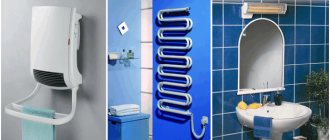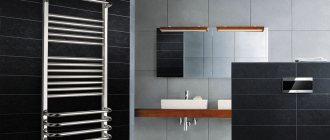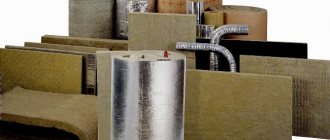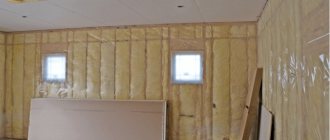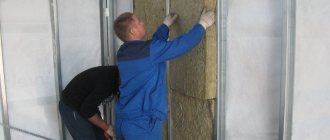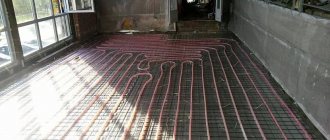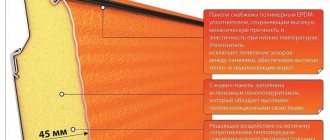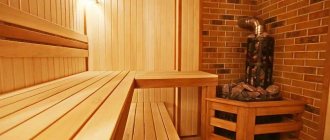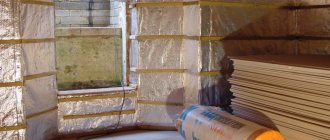As practice shows, it is the insulation of the bathroom from the inside that is the very process that should be given special attention. This is due to the fact that coolness, draft, dampness and other factors will have an extremely negative impact on comfort. What could be the reason?
In fact, there are many factors that influence the atmosphere in the bathroom. This could be not only a problem with the heating system, but also incorrect insulation of walls and floors, as well as a complete absence of any insulation. You can solve the problem either independently or by seeking help from qualified specialists. Let's consider the question of how to insulate a bathroom in more detail.
Materials for thermal insulation
An experienced craftsman has a wide selection of materials with which to insulate thin-walled steel bathtubs with his own hands. They differ in thermal conductivity coefficient, price and method of application. If the thermal insulation of the washing container is carried out before installation, you can use almost any material that suits you in terms of price and quality ratio. The most popular means of insulating steel products are:
- Polyurethane foam sealant. A sealant based on polyurethane foam, popularly known as polyurethane foam, is the optimal material for thermal insulation of a bathtub. It has a low thermal conductivity coefficient and high resistance to moisture, is easy to apply and dries quickly. Many craftsmen choose polyurethane foam for insulating bathtubs because of its affordable price.
- Sheet foil polyurethane foam. Another material that effectively maintains the temperature of water in steel containers is polyurethane foam in the form of self-adhesive sheets. The layer of foil with which the polyurethane foam is supplied additionally reflects heat into the bowl. This material is used to cover the outer surface of the bathtub using a self-adhesive layer or glue.
How to make thermal insulation
There are many materials that will help you insulate your bathtub; let’s focus on the more practical and effective ones.
1. Polyurethane foam. Perhaps this is the most popular option among home craftsmen. The main advantages of foam are:
- low price and consumption (for one hot tub you will need 1, maximum 2 cylinders);
- resistance to high humidity;
- low thermal conductivity;
- ease of application
2. Foil polyurethane foam (penofol). A special insulating material that consists of two main layers.
The first is foam rubber with a large number of air microbubbles (as you know, air is one of the best heat insulators).
For ease of installation, buy polyurethane foam with an adhesive layer, this will greatly simplify your work.
Insulation with polyurethane foam: advantages of use, application technology
Achieving optimal energy efficiency in a bathroom will be achieved by using liquid polyurethane foam thermal insulation as insulation.
Achieving optimal energy efficiency in a bathroom will be achieved by using liquid polyurethane foam thermal insulation as insulation. The advantages of the material include high strength, vapor permeability, heat and sound insulation, fire resistance, and moisture resistance. Polyurethane foam is low weight, so it does not place additional load on the ceiling and walls of the bathroom. The properties of the material allow polyurethane foam to adhere perfectly to any materials. Thanks to the structure of the insulation, free circulation of air masses in the heat-insulating layer is ensured, therefore, there is no need to lay hydro- and vapor barrier films.
The low thermal conductivity coefficient of the thermal insulator allows you to apply polyurethane foam in a thin layer. The result is a monolithic, uniform coating that completely eliminates the formation of cold bridges and the accumulation of condensation under the heat-insulating layer.
Polyurethane foam is sprayed onto insulated surfaces using special equipment, and the technology of its application makes it possible to insulate even rooms with a complex configuration.
Polyurethane foam is sprayed onto insulated surfaces using special equipment, and the technology for its application allows. The biological and chemical resistance of polyurethane foam prevents the destruction of the thermal insulation layer, as well as the formation of fungus and mold.
The polyurethane foam layer is sheathed with moisture-resistant finishing materials, for the fastening of which a frame is constructed. The small thickness of the thermal insulation layer allows you to save the usable area of the bathroom, and you can begin finishing the insulated surfaces within 30 minutes after applying the thermal insulator.
The polyurethane foam thermal insulation layer does not lose its characteristics under the influence of high temperatures, therefore, there is no need to additionally shield the places of its contact with heating equipment.
Video about how polyurethane foam is sprayed from Ecotermix:
Pipe laying
According to SP 30.13330.2016, internal sewage systems should be made of pipes and connecting parts with an estimated service life of at least 25 years. Sewer pipes should be laid with a constant (over the entire horizontal section) slope in the direction of the riser, which is at least 1/D, where D is the diameter of the pipe in millimeters (that is, for a 50 mm pipe, the slope must be at least 2%).
In practice, both polyethylene pipes with welded joints and products made of polypropylene and polyvinyl chloride with detachable socket joints are used. Since the required thickness of the masking screed also increases with the length of the pipe, it is advisable to locate the equipment as close to the riser as possible.
Water pipes (except metal ones with threaded connections) in insulating sleeves made of elastic foam can also be cast into a screed, ensuring a rise towards the water fittings of at least 0.3%. But for water supply it is easier to make horizontal grooves in the partitions.
Ideally, the floor in the bathroom should be 2–4 cm lower than in the adjacent room, but this is very difficult to achieve, therefore, as a rule, a waterproof threshold is made of monolithic concrete, followed by tiling.
Tips and tricks for insulating a bathroom using mineral wool mats
Mineral wool consists of mineral fibers; this insulation composition allows the thermal insulation layer to “breathe”, and therefore prevents the formation of condensation on the walls and ceiling of the room.
When insulating with mineral wool, its hygroscopicity should be taken into account, so the thermal insulation layer must be insulated from contact with moisture. In order to ensure high-quality waterproofing of the insulation layer, hydro- and vapor barrier layers are installed.
When carrying out thermal insulation work, it is necessary to carefully monitor the integrity of the vapor and waterproofing layers, since a violation of their tightness will allow the insulation to absorb moisture, which will negatively affect the thermal insulation properties of the material.
Mineral wool is used to insulate the walls and ceiling of a room. For thermal insulation, it is better to choose mineral wool mats rather than roll insulation. Thermal insulation boards have increased rigidity, and the technology of their fastening, between the frame guides, will prevent the insulation from sliding off vertical surfaces.
It should be remembered that to create a supporting frame it is best to use galvanized metal profiles rather than wooden slats, since wood is not highly resistant to moisture and has a shorter service life. Galvanized profiles have high anti-corrosion properties and resistance to deformation, but wood can deteriorate over time, which will lead to damage to the thermal insulation layer and a decrease in the energy efficiency of the room.
If heating equipment is located in the bathroom, then the contact points between mineral wool and such equipment must be additionally shielded with aluminum foil.
Glass mosaic
- the most expensive option;
- reliability and durability;
- ideal moisture resistance;
- incredibly beautiful decorative effect.
A solution for those who do not count the money in their wallet. Glass mosaic is perhaps the most expensive option from a material point of view to decorate the walls in the bathroom. But how many advantages:
- you can decorate a separate fragment on the wall by selecting elements of similar color;
- easily emphasize rounded surfaces;
- an indispensable material for finishing niches and partitions.
We will not remain silent about the disadvantages. Along with the extremely high cost of such finishing, we also need to talk about complex installation, with which laying ordinary ceramic tiles seems like innocent fun. In addition, you should not place the mosaic in places open to direct contact with water: the sight of constantly flowing drops on the wet glass of the mosaic elements is not the most pleasant sight, alas.
Bathroom floor insulation
To prevent heat from escaping into the ceiling, various insulation materials are used: expanded polystyrene, extruded polystyrene foam and polyurethane foam.
To prevent heat from escaping into the ceiling, various insulation materials are used: expanded polystyrene, extruded polystyrene foam and polyurethane foam. The use of foam boards is extremely rare. This is due to the low density and rigidity of foam sheets. The material is fragile and can release harmful substances when heated.
Extruded polystyrene foam has slightly improved properties compared to polystyrene foam: rigidity, hardness, vapor permeability and higher thermal insulation. But these materials, to ensure the required level of thermal insulation, require the application of significant layers of insulation (over 5 cm). This significantly raises the floor level, especially if you take into account the layer of heating elements, the leveling layer and the decorative coating (laminate, ceramic tiles, etc.). When applying a leveling concrete screed, to ensure the necessary strength, the floor should be additionally reinforced using reinforcing mesh.
The most rational way would be to create a heat-insulating layer using polyurethane foam. This material has the lowest level of thermal conductivity, so it is enough to apply a relatively small layer of material (2 cm) to ensure the required level of insulation. Moreover, polyurethane foam has the properties of a vapor-conducting membrane, which allows moisture to pass from the base, but does not allow it to penetrate deep into the heat insulator.
Before installing the heat-insulating layer, it is necessary to lay a waterproofing film or prime the surface with penetrating waterproofing agents.
The underfloor heating system has a significant heating capacity due to the relatively large heating area. Due to this, high temperatures are not required to heat the room.
Prices for our company’s services can be found in the section
Or order a consultation with a specialist at a time convenient for you!
The application is absolutely free and does not oblige you to anything!
In any apartment or house, the bathroom plays a key role. For some, a bath is comfort and coziness. As you know, a bathroom almost always has high humidity, so the main enemy of comfort and coziness is dampness and, in some cases, cold. It is the cold that creates a temperature contrast that significantly increases the risk of dampness. There are several methods to combat it, for example, installing ventilation, installing a heated towel rail, but this will not fundamentally eliminate the problem of cold.
There is a simple and rational method for insulating a bathroom with your own hands. Based on the fact that it is not always convenient to do this from the outside, you should insulate it from the inside. This is exactly what this article will be about. First, let's look at what insulation materials exist, and then we'll look at how to insulate the floor, walls and ceiling.
If there is a choice between external and internal insulation, then preference should be given to the first, since such insulation is more effective
Foamed polyethylene
You can soundproof your bathtub yourself using polyethylene foam or so-called polyethylene foam, abbreviated PPE, which is an excellent sound, heat and waterproofing material. This material is a layer of bubbles filled with air.
A little about suitable material
The process of soundproofing a metal bathtub made of a steel alloy with your own hands involves the use of modern modifications and developments of foamed polyethylene, which has an additional foil or metallized layer, such as isolon, peonozol, etc. Such materials have the property of additionally retaining the heat of a filled bathtub.
Features of the work
The simplest method of soundproofing is the use of self-adhesive mats, but if such elements are missing, then you will need to use a high-quality adhesive. At first glance, the gluing process itself does not present any difficulties and is extremely simple. To do this, the bathtub must be treated with glue, then apply and press the prepared insulation. In fact, when using this method in practice, it is quite difficult and labor-intensive to soundproof a bathtub yourself, since this process takes a lot of time.
Insulation of the bathroom
Many people have experienced a feeling of discomfort while in the bathroom. This is due to the fact that cool air enters from the sewer shaft and other cracks.
To avoid such unpleasant sensations, the bathroom must be insulated correctly, using only high-quality materials:
- The wall is cleaned and coated with a preparation that prevents the formation of fungus;
- Glue penofol or extruded foam to the wall;
- Moisture-resistant drywall is glued over the glued material;
- Ceramic tiles are laid on top of the drywall.
There is another way to insulate bathroom walls:
- In addition, it may be necessary to insulate the bathroom ceiling; the best option is to install a suspended plasterboard ceiling. The space between the ceiling and drywall is insulated with foam plastic.
It is also important that the bathroom ventilation effectively removes the vapors generated in the house outside. In order to insulate the ventilation, it is necessary to prevent the penetration of air from the street into the bathroom through it
This is achieved by installing special grilles with a fan on the ventilation openings, which draws out vapors without allowing outside air into the room. In any case, the sewer shaft should be insulated, since it is a source of drafts that draw out heat and prevent the bathroom from warming up properly.
Other ways
In addition to all of the above methods, there are also other methods for insulating a metal bath with a steel alloy:
- Very often, a steel container is installed on a pre-prepared pedestal. After this, the product is covered with bricks or slabs, on top of which tiles are laid. With this method of installing a bathtub, sound insulation is improved, but it is not possible to fully retain heat in the bathtub. But, if you apply a layer of polystyrene foam, which is additionally placed on the inside of the wall of the bathtub container, you can correct the situation without any problems
- If you need to seal and attach the product to the wall in the bathroom, you can use liquid nails or special silicone. If treated with polyurethane sealant or other insulating materials, subsequent decoration is required to cover up the unaesthetic appearance of the product.
Currently, the modern market presents a huge range of materials for interior decoration. The presence of fashion trends for decorating bathroom interiors allows you to easily use any method of installing and soundproofing a hot tub, so take into account your financial and technical capabilities when choosing the appropriate method. Good luck completing the renovation!
Steel bathtubs immediately won the hearts of consumers who were fed up with Soviet cast-iron models. But even despite this, they have 2 very unpleasant drawbacks:
- High thermal conductivity.
That is, the bowl gives off heat to the environment very quickly, so you constantly have to add hot water. This is very expensive, given that utility tariffs are constantly increasing. - Acoustic resonance.
If you draw water into an iron bathtub without sound insulation, neighbors at a distance of 2 floors will be able to hear this ringing.
The above problems are not critical; they can be easily dealt with at the stage of installing the font.
In our article today we will look in detail at how to insulate a steel bathtub and reduce thermal conductivity. Read our special article on how to make sound insulation.
How to keep your bathroom warm
Before you start insulating the walls, you need to take care of the heat that will need to be retained. In this case, heating through radiators is not able to fully cope with this task. In addition, they heat only during the heating season. It is for this reason that experts recommend installing an electric heater in the bathroom, for example in the form of a heated floor.
To install a heated floor, a two-core cable is used, which is laid on the floor at a certain frequency. The more often the heating wire rings are located, the more effective the floor heating will be. The laid structure is filled with a concrete screed; only one wire remains outside, intended for connecting to the network.
Heated floors in the bathroom allow you to enjoy the warmth even after the central heating is turned off.
Determining the power of the heating system.
To obtain the most accurate information regarding the optimal operating mode of an electric floor, you need to consult with a specialist, however, the vast majority of companies that produce underfloor heating elements recommend equipping bathrooms with heating systems with a power of 160 W/m2.
By means of simple mathematical calculations, namely multiplying the area of the heated surface by the heating power of one square meter, we obtain the total power that must be provided when installing an electrical “warm floor” system in the bathroom.
How to insulate a metal font with your own hands
Below are detailed step-by-step instructions for insulating an iron bathtub using foil polyurethane foam (penofol).
For detailed instructions on thermal and sound insulation of a bathtub using polyurethane foam, see our special article.
Step 1. Place the bathtub against the wall or lay it upside down on the floor, after covering it with cardboard or cloth. This is necessary to avoid damage to the enamel.
Step 2. The next step is to degrease the surface. A universal degreaser is perfect for this. But if you don’t have it, it doesn’t matter, you can use alcohol or regular dishwashing detergent. Wipe the entire surface thoroughly and let it dry for 10-15 minutes.
Step 3. If you have insulation in rolls, cut a piece of the required length so that the bowl is covered crosswise from side to side, as shown in the photo. Don't forget to peel off the film from the adhesive layer.
After you have glued the sheet to the bathtub, you need to trim off the excess and once again iron the insulation tightly with your hand so that there are no bubbles.
Step 4. Measure the width of the most even areas and cut strips of 15-25 cm. Then glue them to the bowl in the same way, cutting off the excess.
Step 5. Next, glue the remaining empty spaces with the same small strips.
Don't forget to cut a hole for the drain.
Step 6. Tape the insulation joints with reinforced tape.
Step 7. Remove the insulation from the mounting points of the legs.
Polyurethane foam
Many consumers are wondering how to thoroughly insulate a steel bathtub. To solve this problem, polyurethane foam is used, which is used in construction and repair work to seal doors and windows.
Let's look at how to soundproof a bathroom using polyurethane foam with your own hands. For this:
- We turn the bathtub container over and slowly apply a layer of polyurethane foam, having previously degreased the surface. For this purpose, an alcohol-containing composition is used, which should be used to treat the outer surface of the bathroom.
- For ease of use, we turn the container over from its legs and place it on the side of the bathtub, using some kind of soft surface to prevent accidental scratches and any damage.
- We apply the mounting foam evenly, in a continuous layer, and carefully ensure that there are no gaps. Since polyurethane foam has the property of fluidity, the layer must be applied very slowly. After the coated foam has dried, the bathtub must be turned over to the other side.
Before you start treating the outer surface of the bathtub with polyurethane foam, you need to familiarize yourself with some recommendations:
It is much more practical to use polyurethane foam to treat a bathtub in the summer, since this product is resistant to high temperatures and swells better; polyurethane foam must be used only for indoor use; to form a uniform layer without sharp gaps, bumps and drips, it is preferable to use a special nozzle for applying foam; for this, a construction gun is used; Do not treat the overflow area with polyurethane foam; Before starting treatment with foam, it is recommended to heat the container under running hot water and shake well - with this procedure, the largest yield of foam will be observed, and at the same time it is very economical; it is not recommended to cover the siphon installation area and the area adjacent to it with a layer of foam, since at any time, if necessary, this part must be accessible for replacing the siphon; When processing with polyurethane foam, be sure to pay attention to the expiration date, after which the used product loses its performance properties.
Foam selection rules
When purchasing cans of foam for soundproofing a bathtub with your own hands, pay attention to its type. For planned processing, the ideal option is polyurethane foam, also called polyurethane sealant
After hardening, such foam expands from 1.5 to 2 times. This is very convenient, since the created layer slightly increases the size of the bathtub container and does not complicate subsequent installation.
With this application, a dense, uniform “casing” is ultimately formed. When treating with polyurethane sealant, having reached the location of the drain system fastening, this area can be left free. At the same time, you not only save foam, but in the future you do not have the problem of cutting it off. These tips will help you soundproof your bathtub yourself without making mistakes.
The advantage of soundproofing a bathtub with polyurethane foam
Carrying out high-quality sound insulation and insulation of a bathtub using polyurethane sealant is a profitable solution:
- The minimum amount of money and time spent is characterized by such an option as a budget option, which can be used by everyone.
- Unlike vibroplast, this product does not require any special effort to process the bathtub.
- If you strictly follow the above recommendations and preview the video of the master class, then every owner will be able to use this technique without any problems. The only condition is the correct and careful selection of the foam needed for the job.
Wall insulation
The simplest but most effective method of insulating a bathroom from the inside is to cover it with foam boards. First of all, you need to stock up on tile adhesive, foam sheets, a rubber roller, finishing putty, putty knives of different sizes, a serrated trowel and a utility knife.
First of all, it is necessary to prepare the walls, clean them of dust and old coating, and then apply several layers of antiseptic primer. The glue, previously mixed with water, should be applied to the foam sheets with a notched trowel. Then the foam needs to be installed at the attachment point so as not to break the sheets, and then rolled with a rubber roller. Once all the sheets are glued, you can begin to putty. The mixed finishing putty is applied in an even layer to the walls. After it dries, the walls will need to be painted or finished from the inside in other ways.
“Warm” plaster is a cement-based insulation material that has appeared on the building materials market relatively recently, so not all craftsmen use it to insulate walls. To reduce the thermal conductivity of the coating, it is advisable to use special additives instead of sand. Warm plaster can have the following compositions. The sawdust composition usually uses sawdust and cellulose, so insulation with this material is best done in dry rooms to avoid mold on the walls. As a filler for the vermiculite composition, a mineral is used that has poor thermal conductivity and low weight - expanded vermiculite. It is better to choose this plaster for wet rooms, as it has antiseptic properties. In polystyrene foam composition, polystyrene foam granules are used as filler.
Insulating a bathroom with “warm” plaster occurs quickly, since in this case there is no need to level the walls, moreover, the material has excellent adhesion to all materials and does not form cold bridges. But to achieve a good effect, the plaster will have to be applied in a thick layer, about 2 times thicker than when applying the composition to foam plastic. Plaster is not a finishing coating, so it is necessary to finish it with another material.
Before applying “warm” plaster to the walls, they must be thoroughly cleaned of dust and old coating and primer applied. After this, a composition should be prepared from the dry mixture and water, which should be applied to the walls with a wide spatula. Remember that the plaster should not be applied immediately in a very thick layer; the optimal thickness should not exceed 2 cm, and each layer should be allowed to dry for 4-5 hours. If you do not adhere to this rule, then soon the plaster will begin to crack and peel. Insulating the walls of the bathroom from the inside will allow you to stay in the room comfortably, and will also prevent the appearance of condensation and, accordingly, dampness.
Work order
To insulate a bathtub you need to take only three steps, which are shown in the diagram below.
Stages of insulating a bathroom.
And now about each of them in more detail.
Stage 1 - Surface Preparation
As you understand, we will insulate the walls and ceiling. But first you need to prepare these surfaces for work. The sequence of actions is as follows:
- I empty the bathroom of furniture and plumbing fixtures. This is precisely one of the disadvantages of internal insulation technology. To install polystyrene foam on the walls, you need to remove the bathtub, sink, washing machine, and so on from the room. Therefore, thermal insulation measures are usually timed to coincide with general repairs in the plumbing unit.
First of all, you need to dismantle the plumbing fixtures.
- I remove decorative trim from the walls. In my case, all surfaces were tiled. So I knocked down all the parts using a hammer drill with a chisel attached to it. Moreover, you need to get rid of not only the tile itself, but also the remaining glue to get as smooth a surface as possible. In the case of other materials, you can proceed as follows:
- The wallpaper is simply torn off the walls, after which the surfaces are protected with a spatula from remnants of the backing and glue.
- You don’t have to remove all the paint, but get rid of only those areas that are already swollen or crumbling. The rest of the layer will not interfere with the work.
The ceramic tile or other trim is then removed.
- I carry out repairs to wall and floor surfaces. Before laying the insulation, you must make sure that the surfaces do not have cracks, potholes and bumps that could interfere with the adhesion of the foam or cause moisture to penetrate into the thickness of the insulating layer:
- Small and shallow cracks need to be slightly widened with a grinder with a diamond disc installed on it, and then filled with polyurethane foam. After hardening, the latter is cut flush with the wall or floor.
- Large recesses are cleaned with a chisel to get rid of crumbling areas, and then filled with cement repair mortar. If reinforcement is visible in the recess, then before repair it must be cleaned with sandpaper and coated with a rust converter.
Cracks and defects in concrete walls and floor slabs need to be repaired.
- I clean the surface from dust. It is best to do this with a vacuum cleaner, which will remove even the smallest particles of dust and mineral chips.
A vacuum cleaner is best for cleaning concrete.
- I prime the walls and floor. The composition I have chosen not only improves adhesion, removes dust from concrete slabs and gives them antiseptic properties, but also kills all microorganisms that already live on the surface of the slabs. Priming is carried out according to the following scheme:
- First, using a roller (or, to speed up the process, a sprayer), the walls are coated with a primer in one layer.
- After this, you need to give the composition time to dry. This usually takes about 4 hours.
- Then the walls of the room are coated with primer again. After the second layer has dried, you can proceed to gluing the foam.
The walls and floor need to be primed in two layers.
- I'm laying out the electrical wiring. If you need to lay electrical cables and install sockets in the bathroom, you need to do it now. For installation, polyvinyl chloride cable channels are used, which in the event of a short circuit will prevent the insulating layer from igniting. And the polystyrene foam itself is easy to process, so you can then hollow out recesses in it to mask these cable channels.
You need to worry about the wiring in the bathroom in advance.
Stage 2 - Installation of thermal insulation on the walls
Let's start insulating the walls. I’ll say right away that although the gluing process seems simple, it contains many small nuances on which the quality of the work performed ultimately depends.
The technology is as follows:
- I hit the zero mark. To do this, you need to mark a mark at a height of about 52-55 cm from the floor, following which, using a water or laser level, draw a strictly horizontal line over the entire surface of the walls in the bathroom, which will serve as a guide for gluing the foam sheets.
The zero mark can be marked using a laser level.
- If necessary, I carry out marking and cutting of foam sheets. The material is easily cut using a utility knife, a hacksaw with sharp teeth or hot metal wire. Let me point out a few nuances:
- When cutting, maintain the dimensions very precisely so that when gluing, the seams between the individual sheets are minimal.
- To ensure a tighter fit of the sheets, after sawing off the part, you need to process its end using a foam grater.
Operating principle of cutting wire for foam plastic.
- I am preparing a reinforcing composition for polystyrene foam. For this, a dry construction mixture is used, to which water is added, after which everything is stirred and brought to homogeneity using a mixer connected to a drill. In this matter, it is important to pay attention to several points:
- After mixing, it is necessary to leave the glue for 5-7 minutes so that the additives and plasticizers included in its composition are activated. After this, the solution should be mixed again.
- Prepare only the amount of glue that you can use in about 40 minutes. After this time, the performance properties of the solution deteriorate.
- To prepare a new portion, you need to use a clean container (or wash the old one well). Otherwise, frozen lumps from the previous batch can spoil the glue and interfere with the correct alignment of the foam boards.
The solution is mixed using an electric mixer.
- I spread glue on the first sheet of foam. The glue application pattern will be the same for all sheets, but it has several features that are important to know:
- If the wall is smooth and there is no need to level it with polystyrene foam, then glue is applied to the entire surface of the foam plastic, after which it is spread with a notched trowel.
- If you need to level the wall, then apply the glue with a roller along the edge (at a distance of 5 cm from it with small gaps for air to escape), after which several lumps are placed in the middle so that at least 40% of the area of the material is covered with the composition.
- Polyurethane glue from a balloon is applied in the form of separate lumps (about 6-8 pieces), distributed over the entire surface of the insulation.
- If the foam sheets are joined at an angle of 90 degrees, then the area that is adjacent to another part of the insulation does not need to be coated with glue.
- During work, you should carefully ensure that the cement-based adhesive does not get into the seams between the sheets of expanded polystyrene.
Applying glue to foam sheets.
- I secure the first sheet of foam. You need to start work from the corner above the zero level line (drawn in advance on the walls). The system is like this:
- You need to fix the part on the wall, and then align it vertically, controlling the location using a water level.
- After this, further strengthen it with four umbrella dowels. You need to drill a hole in the wall directly through the foam, then insert the dowel, but do not hammer in the core, but only insert it all the way, otherwise you can knock down the level of the foam sheet.
To make work easier, you can install the support rail at the zero mark.
- I glue the remaining sheets on top from the zero mark. When applying glue and leveling, you need to act as indicated in the previous two paragraphs, as for the remaining nuances:
- When joining two adjacent sheets of the same row, it is necessary to ensure that the parts fit as tightly as possible to each other. If necessary, you can use a polystyrene foam grater.
- When installing the top row on the bottom, you need to make sure that the seams of the material run apart, that is, the seam of the top is separated from the seam of the bottom row of foam at a distance of at least 20 cm.
- In the corners, the foam should be connected according to the principle of a ladder. That is, first a sheet comes from one wall, then from the other, and so on in steps to the very top.
- If the wall has too much vertical difference, a polystyrene foam pad of suitable thickness can be glued under the bottom of the foam sheet.
- All sheets of foam plastic are also additionally reinforced with four dowels, the cores of which are not hammered in completely until the glue has completely dried.
- To glue sheets to a cold wall that protects the bathtub from the street, you need to use polyurethane glue if the work is carried out in the cold season.
Installation of expanded polystyrene sheets on the wall.
- I glue the sheets from below the zero line. It is important to secure them correctly, for which pads are used under the lower part of the part. If necessary, trim the insulation using a knife or saw.
- I fill the foam seams with polyurethane glue. You need to pour the foam so that it fills the entire space between the foam sheets, and not just at the top of the seam.
- I secure the insulation sheets with dowels. This must be done after all the glue has dried. First, the cores of those parts that were already inserted during gluing are completely hammered. Then the number of dowels increases to 6-8 per sheet. It is also advisable to drive fasteners into the seams between the sheets to strengthen them too. The dowel must be hammered in so that its head is submerged and does not rise above the surface of the polystyrene foam.
Scheme of fastening foam plastic with dowels.
- I perform final cleaning of the foam surface. To do this, use a polystyrene foam grater. With its help, it is necessary to especially carefully process the foam seams (if there are small differences in height) and outer corners (if any).
A grater for cleaning foam plastic.
- I reinforce the outer corners of foam plastic. In the bathroom where I was renovating, the wall has a complex shape, so the foam insulation formed two outer corners. They need to be reinforced using a corner with a mesh. This is done like this:
- A small layer of reinforcing compound (glue that was used to glue the insulation) is applied to both sides of the corner.
- A corner is applied, after which, using a plaster float, it is pressed inside the insulation.
- Then a little more solution is applied on top with a spatula, which is distributed in the direction from the corner outward.
Part for reinforcing corners and method of its installation.
- I reinforce the surface of the foam with mesh. A pre-purchased fiberglass alkali-resistant mesh is used:
- A reinforcing compound is applied to the surface of the insulating layer.
- A mesh is glued onto it, after which it is pressed into the solution with a grater.
- A little more composition is applied on top, which is then carefully leveled.
- At the junction of individual sheets and in the corners of the room, the mesh should be overlapped.
- When leveling, use the blunt side of a plastering float to avoid tearing the reinforcing layer.
Polystyrene reinforcement with mesh.
- I complete the final plastering of the wall surface with cement mortar. Further technology depends on the chosen finishing material. If you are going to glue tiles, then you do not need to bring the surface to perfection, but for painting and wallpaper you will have to carefully plaster, putty and sand everything.
The last stage of wall insulation is their decorative finishing.
Stage 3 - Floor insulation
To insulate the floor, instead of polystyrene foam, I took extruded polystyrene foam from the Penoplex brand. This material has a high density, so it better tolerates mechanical loads exerted on the insulated surface.
I will describe the work scheme briefly so as not to abuse your attention:
- A polyethylene film is laid on the prepared floor. It plays the role of a waterproofing membrane and is used to prevent penoplex from getting wet.
- Sheets of thermal insulation material are laid. You can lay one layer 5 cm thick or two layers 10 cm thick. In my case, 5 is enough, since below there is also a living space and there is no need to protect yourself from the severe winter cold. The styling features are:
- The material is simply laid out on the floor without fastening. There will be a cement screed on top that will firmly hold the insulation sheets in place.
- The ends of the penoplex are designed in the form of a step, which allows you to tightly connect the parts and avoid the appearance of cold bridges.
- When laying the material in two layers, you need to ensure that the seams of the bottom row are at intervals with the joints of the top row.
Laying penoplex on the floor.
- Reinforcing mesh is installed. What is needed here is not fiberglass, but a metal mesh made of steel wire with a mesh size of 10 cm. The laying technique is as follows:
- Individual sheets of mesh are laid out on polystyrene foam in such a way that they overlap each other at a distance of one cell.
- Plastic legs are placed under the mesh, which will hold it at a height of 2-3 cm above the level of the insulating material.
- The sheets of the reinforcing layer are connected to each other using steel wire.
Reinforcement of penoplex with mesh (photo from another object).
- Beacons are being installed. For this purpose, special aluminum parts and brackets are used. The beacons need to be leveled using a water or laser level in order to achieve a perfectly flat floor in the end.
- The screed is being poured. A solution is prepared, poured into the space between the beacons and leveled with an aluminum rule.
Performing a foam screed with simultaneous installation of a heated floor.
Floor insulation
It is best to start insulating a bathroom floor with waterproofing. After all, all the moisture that gets on the walls still flows onto the floor. And if an accident suddenly happens, the water will quickly penetrate into the neighboring apartment.
To prevent this, you should use penetrating or adhesive-type waterproofing materials. But it is best to apply liquid rubber to the surface, because as soon as the material dries, it completely isolates the building structures from moisture penetration. It is not very practical to insulate the bathroom floor with polystyrene foam. The fact is that the floor will rise, and an additional screed will have to be built above the insulating structure in order to lay tiles or laminate. Therefore, it is best to install a heated floor system.
At the moment, there are many options for heating the floor in the bathroom. For example, you can heat the floor using hot water; you can also install an electric heating cable or special heating mats into the base of the floor.
Insulating the floor using the first method is not very practical, because the hot water in the pipes gradually cools. In addition, process water is not purified; it contains many impurities that precipitate and clog pipes. When there is no hot water in the system, it will not be possible to heat the bathroom floor.
So, in order to insulate a room with electric mats, you first need to level and clean the base under the mats, and in some cases a concrete screed is specially made for the structure. The mats need to be laid on concrete, they are already protected from moisture by special materials, after which the system should be filled with concrete. The design includes a thermostat, with which you can regulate the amount of heating of the room, while the entire system operates from a regular electrical network
It is recommended to entrust the installation of an electric floor heating system to specialists, because it is very important that the electrical wires are insulated correctly. If you have a choice between water floor heating and electric mats, then it is better to give preference to the latter
Warm floors guarantee high reliability and long service life, and they are also quite cheap.
If you do not have the opportunity to install heated floors, then you can insulate the floor in the bathroom using insulating material. However, in this case, the structure will need to be covered with a concrete screed. To begin with, the floor is leveled and cleaned, then a layer of waterproofing is applied and left to dry. At the next stage, the structure needs to be filled with concrete, after which you can lay tiles or other facing material
Remember that, despite the simplicity of installing the floor, you must be careful when performing work and follow all safety requirements
This completes the insulation of the bathroom from the inside. Properly performed work will significantly improve the feeling of coziness and comfort that occurs when taking various water procedures, since it is quite difficult to call being in a damp, cold room comfortable.
Common mistakes at the initial stage of repair
Errors arise for two reasons: great haste when making the final decision and lack of practical experience in performing such work.
Be sure to redo old sewer and water pipes. The fact is that they have a guaranteed service life; in such buildings it is at its limit. Worn pipes may develop leaks several months after major repairs. It takes a lot of money and time to fix problems. It is much more profitable to anticipate the occurrence of force majeure situations than to eliminate them later. sewer pipes
The electrical circuit in the bathroom must be thought out before starting work. At the same time, install sockets not only for the existing equipment, but also for the future. Increase the number of sockets, select the cable cross-section taking into account the possible increase in the total power of electricity consumers.
Install the bathtub in such a position that its dimensions allow you to place a maximum of household appliances in the room, do not interfere with the connection of the sink, etc. It is better to have one piece of free space next to the bathtub with a fairly large area than several small ones. The bathtub should not divide the room into several zones.
When decorating walls with ceramic tiles, it is not recommended to get carried away with a large number of decorative elements: borders, special internal and external corners. Such elements are very expensive. In terms of area, they occupy no more than 10–15% of the walls, and in cost they can exceed the price of the rest of the tiles. In addition, decorative elements often have various convexities, which create difficulties during the installation of plumbing fixtures - the fixation planes of sinks and toilets are flat and must be mounted on the same flat walls.
The dimensions of the doorway must match the dimensions of the doors. There are times when it is necessary to install non-standard doors, but the opening has already been made and the walls are tiled. To expand the opening, you have to not only saw off part of the partition, but also the tiles
As a result of such actions, it cracks and a complete replacement of the adjacent row is required.
Pay special attention to the position of the partition on which the door will be installed. Theoretically, the tiles can be laid on a sloping wall, although it is better to avoid this
And installing a door on a slanting wall is even theoretically impossible. There will always be a gap between the wall and the platband; it will not be possible to make it invisible.
Consider ways to install inspection hatches. The use of cheap plastic models is currently not recommended even for budget bathroom options. Modern hatches with magnetic covers look much better. Installing them is not a problem; you just need to plan the specific placement at the stage of marking the tiles.
Bathroom ventilation must be reliable and efficient, with an air exchange rate of at least 7. In order to save thermal energy, it is recommended to install an electric fan in the room and turn it on only during water procedures. Just keep in mind that connecting such fans to existing general house systems is strictly prohibited; issues should be resolved with specialists.
It’s not difficult to follow the recommendations; don’t be lazy to think and weigh your decisions. Remember that it is always much easier and cheaper to do quality work than to eliminate defects later.
Materials and tools for bath insulation
As insulation we use polyurethane foam and sheet foam 2-3 cm thick. We calculate the approximate consumption of materials as follows. Find the surface area of the bathtub by treating it as a rectangular box. To do this, measure the dimensions on the inner sides. An ordinary steel bathtub 1.5 m long has internal dimensions of 1.4 x 0.55 x 0.4 m. We find the perimeter (1.4 + 0.55) x 2 = 3.9 m. Multiplying the perimeter by the height 3.9 x 0.4 = 1 .56 m 2, we get the surface area
Of course, due to the curvature, the area will be smaller, but in practice this is not so important, since polystyrene foam is sold in meter-long pieces
We calculate the approximate foam consumption from the thickness of a conventional layer of 2 cm, that is, we will need about 30 liters of foam (1.56 x 0.02/1000 = 31 dm 3). A 500 ml bottle should be sufficient.
Since we will apply the foam twice, it can be purchased in addition if necessary.
It is better to apply foam using a gun. It is not expensive, about 300 rubles, in addition, if you consider that such a gun saves foam up to 20%, its actual cost will be even lower.
Some pistols are equipped with interchangeable nozzles of various sections and shapes. If you purchased a device without attachments, you can make a homemade tip from a polyethylene or PVC tube of suitable diameter. We heat the end of the tube and flatten it, leaving a narrow gap so that the foam comes out not in a stream, but in a strip.
If insulating an iron bathtub with your own hands is not part of the overall home renovation, you can do without a gun by using ordinary (“household”) cylinders.
Costings
The estimate for installing the system includes the following costs:
- materials - basic and heat-insulating: damper tapes, films, adhesive tape and others;
- components: sensors, thermostats, fasteners, hardware and others;
- screed solutions, glue, etc.;
- surface preparation;
- installation work, installation of wiring, sensor, thermostat;
- screed and cladding.
This is a very approximate list, rather a rough diagram, since the list is individual for different types of sex. This will be discussed in more detail below. It is difficult to name exact costs, since the price of different types of materials fluctuates significantly. And the cost of installation depends on many factors. We can say that the entire set can cost 2–5 thousand rubles per “square”. Laying can cost about one and a half thousand rubles per square. Consultants on our website polaremont.ru will help you choose the appropriate option and outline its cost.
The harm from electromagnetic radiation from heating mats is greatly exaggerated
Vibroplast
The material absorbs vibration well and consists of a layer of embossed aluminum foil and a sticky polymer layer covered with anti-adhesive paper. Easily sticks to uneven surfaces without additional heating. Vibroplast does not absorb moisture and has the properties of a sealant. Suitable for use in the temperature range from -45 to +100°C. Good noise and heat insulator.
- a piece of the required size is cut from vibroplast
- remove the protective paper
- Place it on the surface of the bath and level it
- roll with a roller
Advantages of vibroplast:
- non-toxic
- low price
- withstands a wide temperature range
- moisture resistant
Preparing for cleaning
Before you start cleaning, you need to prepare the room:
- remove bottles with cosmetics, hygiene products and household chemicals from shelves and put them in drawers;
- take out the rug and shower curtain;
- remove robes and towels from hooks;
- clear the bathtub, the surface of the washing machine and the floor;
- check the availability of household chemicals for cleaning surfaces (depending on the cleaning plan);
- Prepare rags, sponges and brushes.
To save time, you can put towels and bathrobes in the washing machine, and soak the mat and shower curtain in a solution of vinegar or disinfectant.
Features of bathroom insulation
A bathroom is a room with a specific microclimate, characterized by significant temperature fluctuations and very high levels of humidity. Therefore, its thermal insulation requires a special approach and I have no right not to mention some nuances.
- The need to destroy the bathroom interior. To insulate the bathroom, you will have to dismantle the finishing and then re-cover the walls with tiles, plastic or plaster. All these operations increase the cost of the project, time for its implementation and labor intensity.
- Reducing the area of the sanitary room. It’s unlikely that anyone’s apartment bathroom is spacious. So, an insulating pie will make the room even smaller. So think about whether all the necessary furniture and equipment will fit there after insulation.
- Impaired air infiltration. Vapor-tight insulation does not allow moist air to pass through the walls, therefore, to regulate the humidity in the bathroom, you need to design not just effective ventilation, but forced ventilation - using powerful ones.
- Danger of mold and mildew. This misfortune can only be feared if the thermal insulation is not done correctly.
- Reducing the service life of enclosing structures. If you install insulation inside, the walls of your home will constantly freeze and come into contact with atmospheric moisture, which negatively affects their integrity.
However, in my case, I was not able to install insulation on the 20th floor of a city apartment building, since I cannot pretend to be a monkey dangling at a dizzying height. And I didn’t want to hire a specialist either.
That's why I resorted to internal insulation. Although there are some nuances that need to be mentioned:
- for internal insulation of the bathtub, it is necessary to use materials that have hydrophobic properties and do not lose their performance properties when wet;
- it is better to choose materials with the lowest thermal conductivity coefficient so that the insulating layer is as thin as possible;
- For internal insulation, materials with great strength are required to maintain integrity during finishing and possible mechanical stress.
Bathroom in a private house from scratch
Repairing a bathroom and toilet with your own hands is not an easy task. And if the bath is made from scratch in a new room, it’s even more difficult. We have just such an option. Living in a private house has many advantages, one of them is that you can plan any premises yourself in the right place, guided by various motives. We used to make a bathroom combined with a toilet from scratch, but elsewhere in the house it wasn’t as beautiful. We decided to change its location because we wanted to create an even more comfortable kitchen in the house.
I will tell you how to make a bathroom and toilet in a private house with your own hands using our example and show you a photo.
We started by building a light, durable partition. I won’t repeat myself, read the article “Redevelopment, making a partition with your own hands.”
Cat checking the sinkSince the house is his own, and the sewerage system was previously laid from another room, the husband had to hollow out the foundation, dig a trench along the outside wall and lay a new pipe into the septic tank on a sand bed of 20 cm with a slope of 2 cm per meter (according to standards). Experienced plumbers always follow the rule of not making 90 degree turns. All turns and drains are assembled from two 135 degree angles! It’s good that they told us how to do it right.
Bathroom wall decoration
They brought a sewer pipe into the room, installed a tee: drain from the toilet, drain from the bathtub and sink, and ventilation vertically upward, which was led into a pipe on the roof. If ventilation is not done, the smell from the septic tank will be present in the room.
Then they laid a layer of expanded clay and filled the floor with a cement-sand mixture using a building level. It is advisable to make the floor under the bathtub and sink a little higher so that the water flows to the center of the room without stagnating. It is necessary to check how smooth the walls are and, if necessary, level them with moisture-resistant plasterboard or cement-sand plaster. Gypsum plaster is not suitable for wet areas.
Then you need to install cold and hot water pipes for the sink, bathtub and toilet flush. It is advisable to install polypropylene pipes on welded polypropylene fittings. I had to buy a welding machine for polypropylene.
Pipes behind the bathroom, tap connections
The work is not difficult, but you need to work carefully, strictly according to the instructions, so that the pipe does not overheat and the diameter of the passage hole does not decrease.
Our water pipes are mounted behind the suspended ceiling and run down the wall to the bathtub. They are attached to special fastening clips. It is advisable to insulate exposed cold water supply pipes to prevent condensation from dripping.
Ventilation and heated towel rail
Next we do the electrical work. This is a very individual matter. We have 2 sockets installed, leads for mirror lighting and niche lighting, wiring for ceiling lamps. Electricity must be done by a specialist! It’s good that my husband is an electrical engineer.
Ventilation of the bathroom and toilet in a private house is mandatory! However, as in residential premises. My husband previously punched a hole in the ceiling for the ventilation pipe and installed a plastic sewer pipe into it. You can use a metal pipe. If the attic is cold, the ventilation pipe must be insulated. When the ceiling was ready, I installed an adjustable ventilation valve. Our ventilation is natural.
Improving the quality of steel models
The low price of steel bathtubs forces many buyers to purchase such models, but few know that you can get rid of their main disadvantages yourself, using affordable materials at hand. It is necessary to plan to insulate the outer surface of the bottom of the bowl before installation and connection to the sewer system, since after putting the bath into operation it is problematic to do this. To improve the quality of steel products, the following measures are taken:
- Insulation. Thermal insulation of a steel bowl is carried out using special materials that are applied to the outer surface of the bottom and the machine of the product. The use of thermal insulation material reduces the thermal conductivity of the material, maintaining the water temperature longer.
Selecting a thermal insulator
To insulate the bathroom ceiling, non-hygroscopic, moisture-repellent materials should be used.
To insulate the bathroom ceiling, non-hygroscopic, moisture-repellent materials should be used. See tips for choosing thermal insulation materials here. The insulation must be safe for human health and maintain its thermal insulation properties in conditions of high humidity and significant temperature changes.
To insulate the bathroom ceiling, it is not recommended to use cotton wool insulators due to their high hygroscopicity and the need to additionally install a supporting frame. It is best to give preference to extruded polystyrene foam, polystyrene foam or polyurethane foam.
Preparation
To properly insulate a steel washing container with your own hands, you need to carefully prepare the bathtub for use. If you apply polyurethane foam or glue thermal insulation material to an unprepared surface, you will not be able to achieve the optimal result. Before performing insulation, perform the following operations:
- You need to put cardboard, soft material or wooden blocks on the floor of the bathroom to place the washing container on them.
- Disconnect the font from the drainage system, disconnect the siphon and overflow.
- Turn the bowl upside down, and then lower it onto the prepared bars.
- Clean the outer surface of the bowl from dust or dirt.
- To degrease steel baths, use gasoline, alcohol or solvent.
Liquid acrylic
The significant difference between it and all of the above materials is the consistency of the substance - it is liquid, and also in the use. Liquid acrylic is freely sold at any hardware or construction store.
How to use - it is used to treat the inner surface of a steel bathtub. The only downside is its pungent odor and the long time it takes to dry (48 hours).
For sound insulation, a mixture of components is usually used:
- semi-finished product from acrylic enamel;
- hardener No. 144.
Plus - in addition to sound insulation, the material improves the external aesthetic qualities of the bath.
Processing technology:
- finish the surface using sanding paper or cleaning material;
- wash away dirt;
- degrease the walls with a simple alcohol-containing solvent;
- dry the surface;
- remove the siphon and carefully wrap the taps with film;
- apply acrylic using the pouring method, covering the inner surface;
- Perform processing continuously, making circular movements.
As the mixture drains, it will leave a thin (about 6 mm) layer. Acrylic is durable and wears out slowly. The procedure itself, if done by hand, takes 2 hours. There are many shades of the substance on the market, it’s easy to choose your own.
Pros of acrylic:
- no drips;
- absence of stains (during and after treatment);
- high strength;
- durability;
- no bubbles;
- improving the external aesthetic qualities of the bath;
- ease of application;
- reduced slipperiness.
